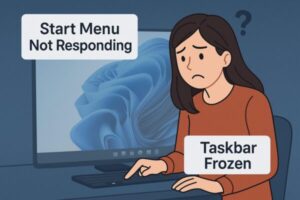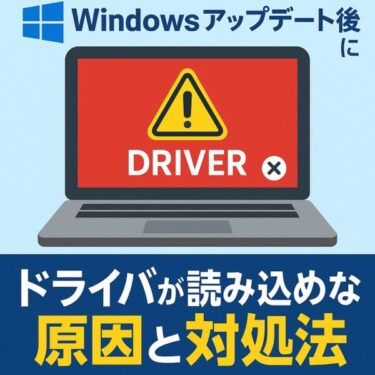
Clicking the Start button but nothing happens?
Does your taskbar feel frozen or completely unresponsive?
You’re not the only one.This is one of the most common Windows UI problems users face in 2025. As of mid-2025, many Windows 11 and 10 users have reported issues where the Start menu, taskbar, or system tray becomes unresponsive — sometimes right after a system update.
This guide will walk you through the possible causes and practical solutions to restore your Windows UI to normal — without having to reinstall your system.
- 1 Common Symptoms
- 2 Cause 1: Windows Explorer (explorer.exe) is Frozen
- 3 Cause 2: Start Menu Package Corruption
- 4 Cause 3: Recent Windows Updates (e.g., KB5060842)
- 5 Bonus Tip: Does It Work on a New User Account?
- 6 Preventive Tips to Avoid UI Breakage
- 7 Why Do These UI Glitches Happen in the First Place?
- 8 Copilot and Search Integration: A Double-Edged Sword?
- 9 Other Contributing Factors
- 10 Advanced Step: Create a New User Profile
- 11 Enterprise Note: Remote or Domain-Joined Systems
- 12 Final Thoughts
Common Symptoms
Here are the most frequently reported symptoms of this UI issue:
- Start menu does not open when clicked
- Right-clicking the taskbar does nothing
- Pinned apps are missing from the taskbar
- Search bar is frozen or greyed out
- System tray icons (Wi-Fi, audio, battery) are unresponsive
These issues may appear suddenly after rebooting, installing updates, or even when starting the PC after sleep.They can seriously disrupt your workflow, so it’s better to address them as soon as you notice something is wrong.
Cause 1: Windows Explorer (explorer.exe) is Frozen
Both the taskbar and Start menu rely on a core Windows process called explorer.exe.If this process freezes, the entire desktop UI (including the taskbar and Start menu) may stop responding temporarily.
▶ Fix: Restart Windows Explorer
- Press Ctrl + Shift + Esc to open Task Manager.
- Switch to “More details” if needed.
- Find Windows Explorer under the Processes tab.
- Right-click it and choose Restart.
This will reload your desktop UI and may resolve the issue immediately.
Cause 2: Start Menu Package Corruption
Windows uses a package-based system to render the Start menu. If this package becomes corrupt or fails to load, the Start button may stop working.
▶ Fix: Re-register Start Menu via PowerShell
This command reinstalls all built-in apps, including the Start menu interface.
It doesn’t touch your personal files, but it may take a while to complete.
- Open Task Manager (Ctrl + Shift + Esc).
- Click “File” → “Run new task”.
- Type
powershelland check “Create this task with administrative privileges”. - Paste the following command:
Wait a few minutes for the process to complete. Then restart your PC.
Cause 3: Recent Windows Updates (e.g., KB5060842)
Many users began experiencing UI issues after applying certain updates such as KB5060842 or KB5060533, which were released in June 2025 as part of the Windows 11 24H2 rollout.
▶ Fix: Uninstall the Problematic Update
- Open Settings with Windows + I.
- Go to Windows Update → Update history.
- Select Uninstall updates.
- Choose the update and click Uninstall.
Note: This is a temporary workaround. Keep checking for future patches from Microsoft that may fix the issue permanently.
Bonus Tip: Does It Work on a New User Account?
Sometimes the issue is tied to a corrupted user profile. Creating a new local account can help you confirm this:
- If the new account works fine, your original profile might need repair.
- Consider migrating your data to the new account.
Preventive Tips to Avoid UI Breakage
To reduce the chance of this issue happening again:
- Manually create a System Restore Point before large updates
- Run
sfc /scannowmonthly to repair system files - Disable unnecessary startup apps
- Keep your device drivers up to date
Why Do These UI Glitches Happen in the First Place?
From a technical standpoint, both the Start menu and taskbar are built upon a set of interlinked system processes. These include explorer.exe, ShellExperienceHost.exe, and the StartMenuExperienceHost.exe.
If any of these processes fail to load properly, the visual shell (your taskbar and Start menu) may not work at all. In many cases, a corrupted user registry hive or pending Windows updates that were interrupted can silently cause these failures.
Copilot and Search Integration: A Double-Edged Sword?
Since the release of Windows 11 version 24H2, the Start menu has become increasingly tied to services like Copilot and SearchUI.exe. These integrations rely on cloud components, and if they time out or fail to initialize, the entire Start interface can become slow, partially load, or even crash.
Some users have reported that disabling Copilot temporarily (via group policy or registry tweaks) helped stabilize the Start menu. However, this may disable helpful features, so it’s a trade-off.
Other Contributing Factors
- Startup apps — Too many background programs at login can delay or freeze the UI.
- Outdated GPU drivers — Graphics drivers can affect rendering of the taskbar and desktop.
- Third-party customization tools — Apps like StartAllBack, Rainmeter, or custom themes can break core UI functionality after updates.
If you’ve recently installed such tools, try removing or updating them before assuming the issue is purely from Windows itself.
Advanced Step: Create a New User Profile
If all UI issues disappear when using a new user account, it’s likely that your existing profile is corrupted. Here’s how to test:
- Open Settings → Accounts → Other users.
- Add a new Local Account (you can skip Microsoft sign-in).
- Log in to the new account and test the Start menu and taskbar.
If the UI works fine, you can consider transferring your files and settings to the new profile permanently.
Enterprise Note: Remote or Domain-Joined Systems
In business environments, taskbar and Start menu issues may also be caused by:
- Group Policy misconfigurations
- Corrupted roaming profiles
- Conflicts with endpoint protection or device control software
If you’re on a company-managed device, check with your IT team before attempting system-level changes like PowerShell commands or uninstalling updates.
Final Thoughts
Start menu and taskbar issues are frustrating, but most of them stem from predictable and fixable causes — from temporary glitches to corrupted system files or unstable updates.
By carefully following the outlined solutions — starting with simple restarts, through PowerShell repair, and even profile migration — you can avoid a full reinstall and get your system back in working order.
Still Not Fixed? Consider In-Place Upgrade Repair
If none of the above works, the safest non-destructive method is an in-place upgrade repair. This reinstalls Windows while keeping your files, apps, and settings intact.
▶ Read the full guide here:
How to Repair Windows Without Losing Data (In-Place Upgrade Guide)
UI issues like a frozen Start menu or taskbar may seem minor, but they often point to deeper system problems. Early diagnosis and structured fixes will save you hours of frustration.


